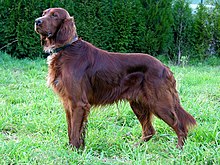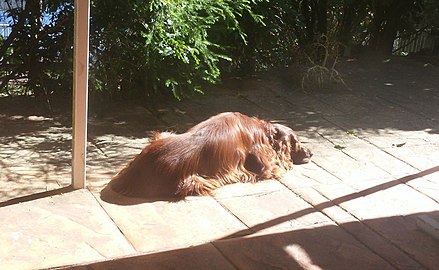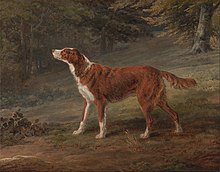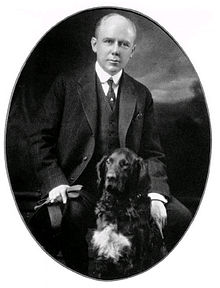| Revision as of 23:09, 3 November 2024 editJessicapierce (talk | contribs)Extended confirmed users113,869 editsm minor copy edits← Previous edit | Latest revision as of 23:14, 5 November 2024 edit undoMonkbot (talk | contribs)Bots3,695,952 editsm Task 20: replace {lang-??} templates with {langx|??} ‹See Tfd› (Replaced 2);Tag: AWB | ||
| Line 9: | Line 9: | ||
| {{Infobox Dogbreed | {{Infobox Dogbreed | ||
| | name = Irish Setter | | name = Irish Setter | ||
| | altname =Red Setter ({{ |
| altname =Red Setter ({{langx|ga|sotar rua}})<br />Irish Red Setter | ||
| | country = ] | | country = ] | ||
| | image = Can Setter dog GFDL.jpg | | image = Can Setter dog GFDL.jpg | ||
| Line 19: | Line 19: | ||
| }}<!-- End Infobox Dogbreed info. Article Begins Here --> | }}<!-- End Infobox Dogbreed info. Article Begins Here --> | ||
| The '''Irish Setter''' ({{ |
The '''Irish Setter''' ({{langx|ga|sotar rua}},<ref>, accessed 14 June 2009.</ref> literally "'''red setter'''") is a ], a ] of ], and family ] originating in Ireland. The term ''Irish Setter'' is commonly used to encompass the show-bred dog recognised by the ] as well as the field-bred Red Setter recognised by the ]. | ||
| ==Description== | ==Description== | ||
Latest revision as of 23:14, 5 November 2024
Large red dog breed for finding and pointing gamebirds| This article needs additional citations for verification. Please help improve this article by adding citations to reliable sources. Unsourced material may be challenged and removed. Find sources: "Irish Setter" – news · newspapers · books · scholar · JSTOR (June 2007) (Learn how and when to remove this message) |
Dog breed
| Irish Setter | |||||||||||||
|---|---|---|---|---|---|---|---|---|---|---|---|---|---|
 Irish Setter Irish Setter | |||||||||||||
| Other names | Red Setter (Irish: sotar rua) Irish Red Setter | ||||||||||||
| Origin | Ireland | ||||||||||||
| |||||||||||||
| Dog (domestic dog) | |||||||||||||
The Irish Setter (Irish: sotar rua, literally "red setter") is a setter, a breed of gundog, and family dog originating in Ireland. The term Irish Setter is commonly used to encompass the show-bred dog recognised by the American Kennel Club as well as the field-bred Red Setter recognised by the Field Dog Stud Book.
Description
Appearance

The coat is moderately long, silky, and of a red or chestnut colour. It requires frequent brushing to maintain its condition and keep it mat-free. The undercoat is abundant in winter weather, and the top coat is fine. Their coats should also feather in places such as the tail, ears, chest, legs, and body. Irish Setters range in height from 24 to 28 inches (61 to 71 cm), males weigh 65 to 75 lb (29 to 34 kg) and females 55 to 65 lb (25 to 29 kg). The FCI Breed Standard for the Irish Setter stipulates males stand 23 to 26.5 inches (58 to 67 cm) tall, and females be 21.5 to 24.5 inches (55 to 62 cm) tall. Irish Setters are deep chested dogs with small waists. An Irish Setter's life expectancy tends to be around 11 to 12 years.
Temperament

Irish Setters get along well with children and other dogs and will greet visitors enthusiastically. Even though they do well with household pets, small animals may pose a problem for this breed, as they are a hunting breed. Some Irish Setters may have problems with cats in the house, and may be too boisterous with small children. As the FCI, ANKC and UK Standards state, the breed should be "Demonstrably affectionate." As a result, Irish Setters make excellent companion animals and family pets.
Irish Setters are an active breed, and require long, daily walks and off-lead running in wide, open spaces. They are, however, a breed with a tendency to 'play deaf,' so careful training on mastering the recall should be undertaken before allowing them off-lead.

Irish Setters enjoy having a job to do. Lack of activity will lead to a bored, destructive, or even hyperactive dog. This is not a breed that can be left alone in the backyard for long periods of time, nor should they be. Irish Setters thrive on constant human companionship. Irish Setters respond swiftly to positive training and are highly intelligent.
Though they are usually alert to their surroundings, Irish Setters are not well-suited as guard dogs, as they are not a naturally assertive breed.
Irish Setters are also widely used as therapy dogs in schools and hospitals. Therapy dogs are permitted in hospitals with special permission and can visit patients on the assigned floors. In schools the dogs may be used to create a calming and relaxed environment. A child may read to a dog without being corrected or judged.
- Irish Setter
-
 Irish Setter in profile
Irish Setter in profile
-
 Two female Irish Setters
Two female Irish Setters
-
 Irish Setter crossing stream in Himalayas
Irish Setter crossing stream in Himalayas
-
 Irish Setter lying down
Irish Setter lying down
History

One of the first references to the 'Setter,' or setting dog, in literature can be found in Caius's De Canibus Britannicus, which was published in 1570 (with a revised version published in 1576). Translated from the original Latin, the text reads:
The Dogge called the Setter, in Latine, Index: Another sort of Dogges be there, serviceable for fowling, making no noise either with foote or with tongue, whiles they follow the game. They attend diligently upon their Master and frame their condition to such beckes, motions and gestures, as it shall please him to exhibite and make, either going forward, drawing backeward, inclinding to the right hand, or yealding toward the left. When he hath founde the byrde, he keepeth sure and fast silence, he stayeth his steppes and will proceed no further, and weth a close, covert watching eye, layeth his belly to the grounde and so creepth forward like a worme. When he approaches neere to the place where the byrde is, he layes him downe, and with a marcke of his pawes, betrayeth the place of the byrdes last abode, whereby it is supposed that this kind of dogge is calles in Index, Setter, being in deede a name most consonant and agreeable to his quality."
It would be incorrect to assume the dog described above in any way resembles the Irish Setter (or any setter) as we know the breed today. Caius was referring to a type of setting spaniel, most likely now extinct. The description of the work undertaken by this early pillar of the breed resembles the working behaviour of modern Irish Setters. Of this early dog, Caius went on to write: "The most part of theyre skinnes are white, and if they are marcked with any spottes, they are commonly red, and somewhat great therewithall." If this is the case, it is safe to assume the solid red colouring of today's Irish Setter came about by selective breeding practices.
Further reference to setters in early literature can be found in The Country Farme by Richard Surflet and Gervase Markham, published in 1616. They wrote: "There is also another sort of land spannyels which are called Setters."
It is clear that, by the early 18th Century, the type of dog known as the 'setter' had come into its own right. It is also clear the Irish had begun actively breeding their own type. For example, the de Freyne family of French Park began keeping detailed stud records in 1793. Other prominent landed Irish gentry also known to have been breeding setter lines at the same time include Lord Clancarty, Lord Dillon, and the Marquis of Waterford.
It was noted as early as 1845 that setters in Ireland were predominantly either red, or, according to Youatt, "...very red, or red and white, or lemon coloured, or white patched with deep chestnut." Clearly, the preference for a solid red-coloured dog was having an effect on the appearance of the typical Irish-bred setter.
The breed standard for the modern Irish Setter was first drawn up by the Irish Red Setter Club in Dublin and approved on 29 March 1886. It consisted of a 100-point scale, with a given number of points awarded for each of the dog's physical attributes. The points system was later dropped; however, aside from some minor changes, the standard remains largely unchanged today in most countries where the breed is formally recognised.
- History
-
 Irish Setter, 1881
Irish Setter, 1881
-
 Irish Setter with a duck, 1855
Irish Setter with a duck, 1855
-
 Irish Setter in 1879
Irish Setter in 1879
-
Irish Setter circa 1915
Uses

The Irish Setter was bred for hunting, specifically for setting or locating and pointing upland gamebirds. They are a tireless, wide-ranging hunter, and well-suited to fields and wet or dry moorland terrain. Using their excellent sense of smell to locate the mark (or bird), the Irish Setter will then hold a pointing position, indicating the direction in which the bird lies hidden.
The Irish Setter was brought to the United States in the early 19th century.
In 1874, the American Field put together the Field Dog Stud Book and registry of dogs in the United States was born. This Field Dog Stud Book is the oldest pure-bred registry in the United States. At that time, dogs could be registered even when bred from sires and dams of different breeds. At about this time, the Llewellin Setter was bred using blood lines from the Lavarack breeding of English Setter and, among other breeds, bloodlines from native Irish Setters. Around the same time, the red Irish Setter became a favourite in the dog show ring.
Not all Irish Setters of the late 19th century were red, the American Kennel Club registered Irish Setters in myriad colours. Frank Forester, a 19th-century sports writer, described the Irish Setter as follows: "The points of the Irish Setter are more bony, angular, and wiry frame, a longer head, a less silky and straighter coat that those of the English. His colour ought to be a deep orange-red and white, a common mark is a stripe of white between the eyes and a white ring around the neck, white stockings, and a white tage to the tail."
The Setter that was completely red, however, was preferred in the show ring and that is the direction that the breed took. Between 1874 and 1948, the breed produced 760 conformation show champions, but only five field champions.
In the 1940s, Field and Stream magazine put into writing what was already a well-known fact. The Irish Setter was disappearing from the field and an outcross would be necessary to resurrect the breed as a working dog. Sports Afield chimed in with a similar call for an outcross. Ned LaGrande of Pennsylvania spent a small fortune purchasing examples of the last of the working Irish Setters in America and importing dogs from overseas. With the blessing of the Field Dog Stud Book, he began an outcross to red and white field champion English Setters. The National Red Setter Field Trial Club was created to test the dogs and to encourage breeding toward a dog that would successfully compete with the white setters. Thus the modern Red Setter was born and the controversy begun.
Prior to 1975, a relationship existed between the American Kennel Club and the Field Dog Stud Book in which registration with one body qualified a dog for registration with the other. In 1975 the Irish Setter Club of America petitioned the American Kennel Club to deny reciprocal registration, and the request was granted. It is claimed, by critics of the move, that the pressure was placed on the American Kennel Club by bench show enthusiasts who were unappreciative of the outcrossing efforts of the National Red Setter Field Trial Club, as well as some field trialers from the American Kennel Club after a series of losses to Field Dog Stud book red setters. Working Irish Setter kennels today field champion dogs that claim lines from both the Field Dog Stud Book and the American Kennel Club.
- Irish Setter
-
 The Irish Setter was bred for hunting.
The Irish Setter was bred for hunting.
-
 Irish Setter
Irish Setter
-
 An Irish Setter after swimming
An Irish Setter after swimming
-
 Irish Setter running in the fields
Irish Setter running in the fields
Working Red Setter
The modern Red Setter is smaller than its bench-bred cousin. While show dogs often reach 70 lb (32 kg), the Working Red Setter is generally around 45 lb (20 kg). The coat is less silky and the feathering is generally shorter. The colour is lighter, with the working dog found in russet and fawn colours. The Red Setter often has patches of white on its face and chest as the Irish Setter of old did. There have been efforts to rekindle the field abilities of the true type Irish by a handful of dedicated breeders in California and elsewhere with some success. More than a dozen American Kennel Club Dual Champion Irish Setters have been made, evidence of the dog's native ability when proper traits are selectively sought in breeding.
Health
A 2024 UK study found a life expectancy of 12.9 years for the breed compared to an average of 12.7 for purebreeds and 12 for crossbreeds.
Gluten intolerance in Irish Setters is a naturally occurring genetic disorder that is the result of a single autosomal recessive locus. At around 6 months of age, Irish Setters with this condition will develop an increased immune cell presence and a decrease in absorption within the small intestine when fed a gluten containing diet. These effects lead to further damage of the small intestine as well as malnutrition and diarrhea. Irish Setters that are fed a gluten free diet have been shown to be exempt from any effects associated with gluten intolerance.
The breed is predisposed to atopic dermatitis.
Miscellaneous
Ireland's national bus and coach operator Bus Éireann uses the Irish Setter as its corporate logo.
Notable setters

- Alex the Dog from the Stroh's beer commercials (half Irish Setter, half Golden Retriever)
- Big Red, book and film character
- Chauncey, fictional dog of Duck Phillips in Mad Men
- Garry Owen, pet of Maine Governor Percival Proctor Baxter
- King Timahoe (1968–1979), pet of Richard Nixon, a 56th birthday gift from his White House staff in January 1969
- Kojak, fictional dog in the Stephen King novel The Stand
- Mike, pet of US President Harry Truman
- Milord, a red Setter which was Alexander II, Tsar of Russia's favourite dog
- Molly, a red setter featured in the John Dies at the End series.
- Peggy Brown, a female Irish setter, the pet of Finnish Air Force Fighter Squadron 24 in World War II
- Plunkett, the only Irish setter depicted in George Earl's mythical painting A Field Trial in the Eighties
- Redbeard, owned by younger Sherlock Holmes in Sherlock
- Seamus, owned by Mitt Romney
- Shamus, an anthropomorphic male Irish setter in Mary Poppins Returns.
- Shannon, pet of Beach Boy Carl Wilson, whose death became the subject of the 1976 song by a friend, Henry Gross
- T-Bone, mascot for the Pace University Setters sports teams
- Thunder, first mascot for the University of British Columbia Thunderbirds sports teams
See also
References
- Ainmneacha Plandaí is Ainmhithe, accessed 14 June 2009.
- Cassidy, Kelly M. (2008). "Breed Longevity Data". Dog Longevity. Archived from the original on 15 May 2012. Retrieved 27 June 2012.
- "Breed Information Centre — Irish Setter". TheKennelClub.org.uk.
- ^ Gardner, E. Irish Setters Today; Ringpress Books Pty Ltd, 1998.
- Boyle, Robert H. (20 November 1978). "Irish with a dash of Limey". Sports Illustrated (Vault).
- McMillan, Kirsten M.; Bielby, Jon; Williams, Carys L.; Upjohn, Melissa M.; Casey, Rachel A.; Christley, Robert M. (1 February 2024). "Longevity of companion dog breeds: those at risk from early death". Scientific Reports. 14 (1). Springer Science and Business Media LLC: 531. Bibcode:2024NatSR..14..531M. doi:10.1038/s41598-023-50458-w. ISSN 2045-2322. PMC 10834484. PMID 38302530.
- Garden, Oliver A; et al. (2000). "Inheritance of gluten-sensitive enteropathy in Irish Setters". American Journal of Veterinary Research. 61 (4): 462–468. doi:10.2460/ajvr.2000.61.462. PMID 10772115.
- Hall, EJ; Batt, R.M (1990). "Development of wheat-sensitive enteropathy in Irish Setters: morphologic changes". American Journal of Veterinary Research. 51 (7): 978–982. doi:10.2460/ajvr.1990.51.07.978. PMID 2389896.
- Hall, E J; R M Batt (February 1992). "Dietary modulation of gluten sensitivity in a naturally occurring enteropathy of Irish setter dogs". Gut. 33 (2): 198–205. doi:10.1136/gut.33.2.198. PMC 1373930. PMID 1347279.
These findings document a gluten sensitive enteropathy in Irish setters and indicate that exclusion of dietary cereal from birth may modify subsequent expression of the disease.
- Rhodes, Karen Helton; Werner, Alexander H. (25 January 2011). Blackwell's Five-Minute Veterinary Consult Clinical Companion. Ames, Iowa: Wiley-Blackwell. p. 94. ISBN 978-0-8138-1596-1.
- "A Decade Later, Watergate's Veterans Are Winners, Losers—and Everything in Between" People, Vol. 17, No. 23 (14 June 1982).
- "Nixon Celebrates Birthday With Surprise Staff Party" The Spartanburg Herald, 10 January 1974
- Nash, John. "The Irish Setter in Sport and Field Trials". IrishRedAndWhiteSetterClub.org. Archived from the original on 6 March 2016. Retrieved 2 April 2018.
- Fergus, Charles. Gun Dog Breeds, A Guide to Spaniels, Retrievers, and Pointing Dogs, The Lyons Press, 2002. ISBN 1-58574-618-5
- Sisley, Nick. "Today's Red Setter". Gun Dog Magazine. Archived from the original on 4 April 2006. Retrieved 25 January 2006.
- Thomas, Jerry (February–March 2005). "Today's Irish Setter". Gun Dog Magazine. 24 (2): 38–43.
Further reading
- Raymond O'Dwyer. (2008). The Irish Red Setter: Its History, Character and Training. Cork University Press. ISBN 978-0-9535353-9-2.
External links
| Dogs originating in Ireland | ||
|---|---|---|
| Extant | ||
| Extinct | ||